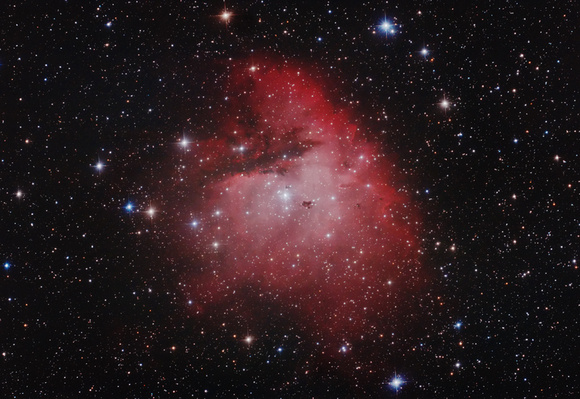Date: 10/4/2011
Target: NGC 281 - Pacman Nebula
Telescope:
Orion 8" f/4.9
Multi-Purpose Coma Corrector
JMI EV-1n Focuser
Resurfaced: Spectrum Coatings Max "R" (EAL)
Camera: Canon 40D (modified, cooled)
Filter: IDAS LPS
Exposures: 70x300s (5.8h) @ ISO1600
Framing: North is Up, 90% crop,
Center (RA, Dec): (13.220, 56.636)
Radius: 0.685 deg
Location: Mocksville, NC
Seeing: 3/5
Transparency: 3/5
Ambient Temp: 50F
Camera Temp: 32F
Start Time: 10:15PM
End Time: 6:13AM
Captured with Nebulosity, stacked using DeepSkyStacker, processed in Photoshop.
Anacortes Wild Bird and Telescope Picture of the Day October 6, 2011From
Wikipedia:
NGC 281 is an
H II region in the constellation of
Cassiopeia and part of the
Perseus Spiral Arm. It includes the
open cluster IC 1590, the multiple star
HD 5005, and several
Bok globules. Colloquially, NGC 281 is also known as the
Pacman Nebula for its resemblance to the
video game character.
The nebula was discovered in August 1883 by
E. E. Barnard, who described it as "a large faint nebula, very diffuse." The multiple star HD 5005, also called β1, was discovered by
S. W. Burnham. It consists of an 8th-magnitude primary with four companions at distances between 1.4 and 15.7
seconds of arc. There has been no appreciable change in this quintuple system since the first measurements were made in 1875.
The nebula is visible in amateur telescopes from dark sky locations. In his book
Deep Sky Wonders,
Walter Scott Houston describes the appearance of the nebula in small telescopes:
[3] There was a faint glow in the immediate vicinity of the multiple star, with an occasional impression of a much larger nebulosity...Its surface brightness was much less than that of M33 in Triangulum or NGC 205, the distant companion of the Andromeda galaxy.


